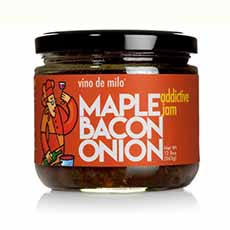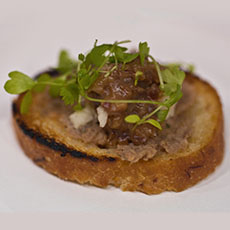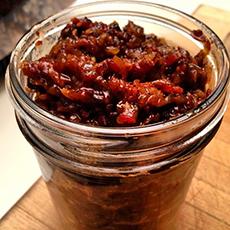TIP OF THE DAY: Bacon Jam For National Bacon Day
|
|
December 30th is National Bacon Day (and if you need to celebrate even more, International Bacon Day is the Saturday before Labor Day). We’re celebrating with bacon jam. Bacon jam is a sweet and savory condiment that adds a little something extra to breakfast, lunch, dinner and snacks. Numerous uses for bacon jam follow, as do recipes. You don’t have to make it from scratch these days. In the last 10 years, artisan food producers have been selling jars of their own bacon jam recipes. Vino de Milo’s Maple Bacon Onion Jam is one such offering, made in small batches with a strong focus on quality. With layers of flavor, the recipe is built on a beef base with roasted onions, apples, brown and white sugars, balsamic and cider vinegars, nitrite- and nitrate-free bacon, maple syrup, hickory smoke and a splash of Merlot wine. One word: yummy! One of our favorite uses for bacon jam is for company canapés/crostini*: store-bought chicken liver mousse or paté, topped with store-bought bacon jam. We prefer a base of toasted baguette (or for canapés, the narrower ficelle, a skinnier baguette). But for an easy-peasy solution, buy some nice crackers. This time around, we simply purchased a box of fig and olive crisps at Trader Joe’s. How about a shout-out to those ancient Middle Easterners who domesticated† the wild boar as early as 9,000 B.C.E., in the Tigris River basin. (The boar was domesticated independently in Asia.) To these brave and hungry hunters and boar-wranglers, we owe ham and bacon—although the modern bacon we know and love wouldn’t appear until the mid-1700s. While boar and pig meat were cured from earliest times (smoked, salted and/or dried). But it wasn’t until the early-to-mid-18th century that a transformation began that distinguished “bacon” as the side of pork (the pig’s sides), cured with salt. The Word “Bacon” The word “bacon” originally referred to all pork. It derived from the Old High German “bacho,” meaning “buttock”—the part we call ham or leg of pork. Numerous food historians credit pig farmers in the English countryside for noticing that some breeds of pig had meatier sides. The British system for making bacon became widespread in the 18th century, and spread to other parts of Europe. As mentioned earlier, by the 1700s in England, bacon was defined as meat cut from the side of the pig and cured with salt. According to The Oxford Companion To Food, the first large-scale bacon curing business was established in the 1770s in the county of Wiltshire, in south-central England, by one John Harris. According to some accounts of the history of bacon, John Harris of Wiltshire set up one of the first bacon curing shops in the country. The place has certainly become known for its production of bacon. In the late 18th and early 19th centuries, Asian pigs were introduced to Europe, and crossbred to create breeds with qualities that made them better as bacon pigs, lard pigs, ham pigs and so forth. Today there are more than 70 breeds in commercial production worldwide. Some English bacon terminology: FOOD TRIVIA: The phrase “bringing home the bacon” purportedly originated in the 12th century, when a church in the English town of Dunmow, an ancient market town in the southeast England county of Essex, offered a side of bacon to any married man who could swear before the congregation and God that he had not quarreled with his wife for a year and a day. You can interpret this as a sexist contest, since wives were deemed to be so quarrelsome that only a man with the patience of a saint (or a deaf ear) could hope to win the challenge. |
|
|
________________ * A canapé is a type of hors d’oeuvre, a category of small, single-bite food. It is traditionally a small piece of bread with a topping. Crostini, made of a topping on toasted bread, can be considered a canapé if the bread is small; i.e., one bite rather than a larger piece of bread. †Because pigs will not allow themselves to be herded like goats and sheep, they were part of agricultural settlements rather than the herds of nomadic peoples.
|
||









